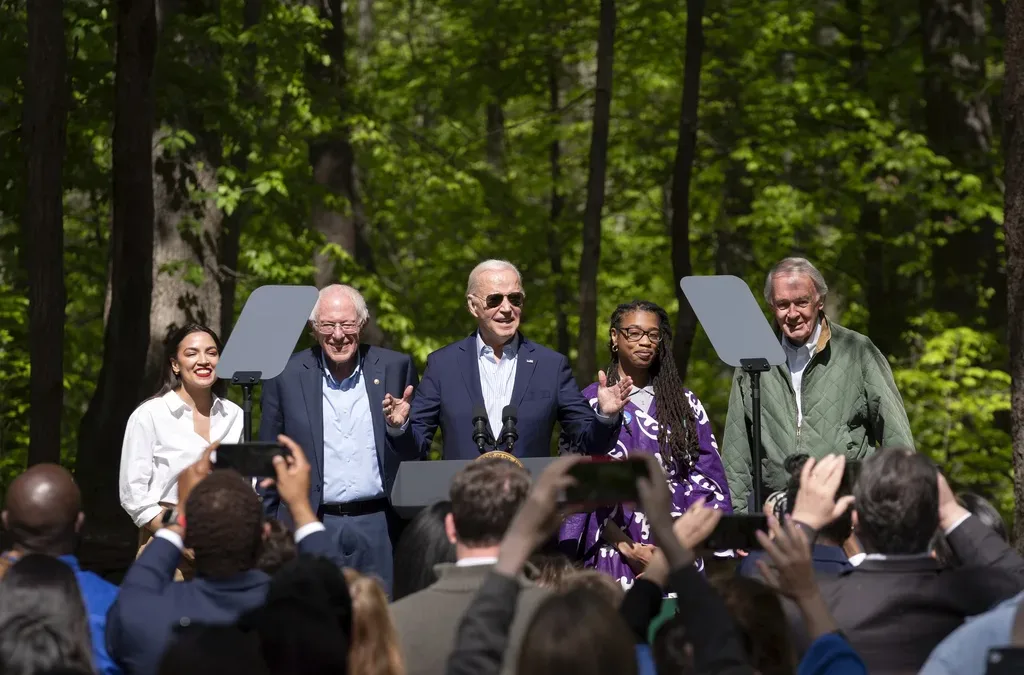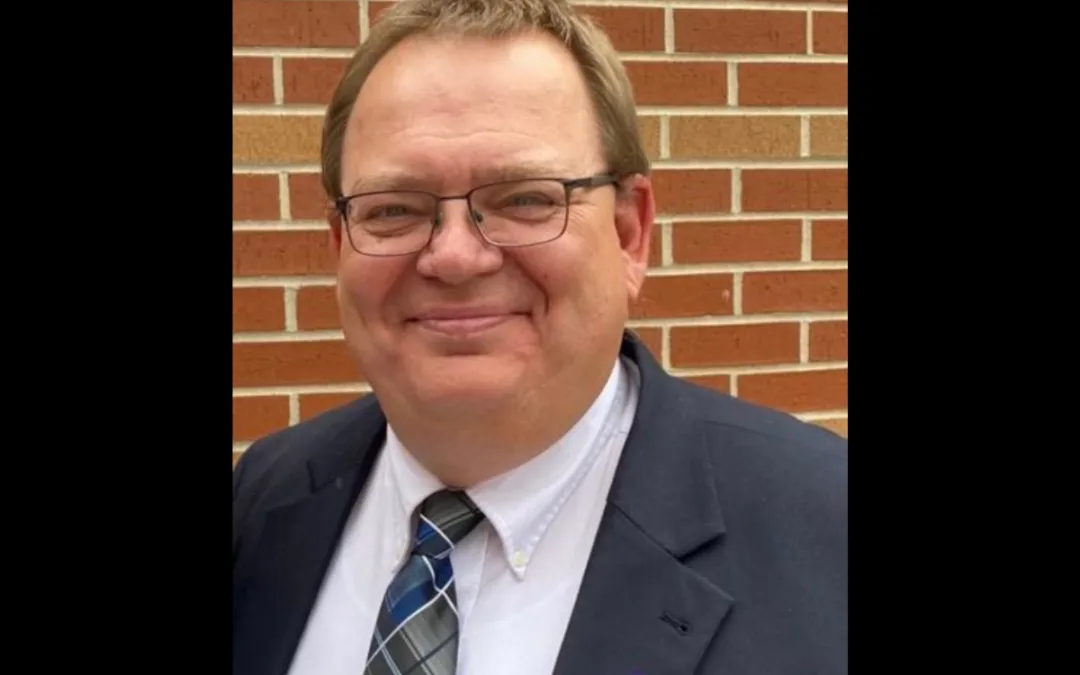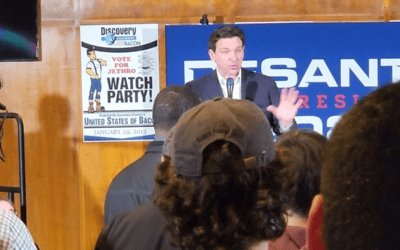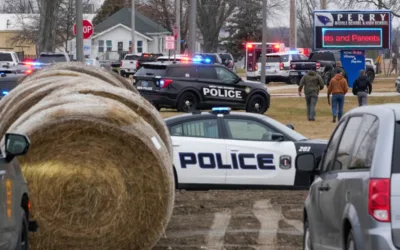
FILE - Family members clean belongings out of a tornado damaged home, Thursday, May 23, 2024, in Greenfield, Iowa. Experts say that planning is key before a tornado threatens. They say weather radios, basements and bicycle helmets all save lives. Record warmth this winter provided the fuel for a deadly tornado outbreak across parts of the Midwest and South in March. (AP Photo/Charlie Neibergall, File)
Right-wing plans for a second Trump administration would put vital, life-saving weather warnings behind paywalls and weaken the agencies who send them out in the first place.
If you’ve ever relied on tornado sirens, nightly weather reports, or alerts from your weather app, you’ve relied on the National Weather Service (NWS).
The federal agency covers weather for the whole United States and it has been on top of monitoring developing weather and issuing warnings to keep people safe.
In fact, the NWS is the only organization in America that issues warnings and watches for severe weather like tornadoes, flash flooding, storm surges, thunderstorms, and more.
All weather information in the United States—whether it’s on local news or on a weather app—comes from the NWS. The radars and satellites that monitor conditions across the country are owned by the federal government, and the data is meant to be available for anyone, for free.
“Our main mission is to provide warnings of weather, water and climate information for the protection of life and property,” said Chad Hahn, the warning coordination meteorologist at the National Weather Service’s Des Moines office.
Those warnings trigger alerts like sirens and emergency text alerts. They also influence how local news stations cover weather events and how cities respond.
“We work very closely with our local emergency officials, particularly the emergency management community across the country, to develop plans and to work through the guidance and guidelines that trigger the things like sirens,” Hahn continued.
NWS’s future
Project 2025, a planning document for a second Trump administration, written by many former-Trump staffers, calls for gutting what the NWS is able to do and putting those forecasts and warnings behind a private company’s paywall.
On pages 674 and 675, Project 2025 suggests having the NWS focus on data collection and work with private companies to provide forecasts.
“The NWS provides data the private companies use and should focus on its data-gathering services. Because private companies rely on these data, the NWS should fully commercialize its forecasting operations.”
Project 2025 also mentions the National Hurricane Center. It acknowledges how important its data is, but then it says: “Data continuity is an important issue in climate science. Data collected by the department should be presented neutrally, without adjustments intended to support any one side in the climate debate.”
No serious scientist doubts the impact of rising global temperatures on the increasing violence and unpredictability of severe weather. Hurricanes are created, in part, by warm water, and the Atlantic Ocean has hit record temperatures this year.
In March 2024, the National Oceanic and Atmospheric Administration—the umbrella agency for the NWS and the National Hurricane Center—predicted an above normal hurricane season.
Project 2025 says all NOAA agencies “form a colossal operation that has become one of the main drivers of the climate change alarm industry and, as such, is harmful to future US prosperity.”
It calls for the whole agency to be “broken up and downsized.”
NWS in action
“Currently, the forecast information that we produce is really important when it comes to the warnings, because you can’t issue warnings and alerts without understanding the underlying forecast and the data within,” Hahn said.
In April, a violent tornado ripped through Minden, a small town of about 600 people in Southwest Iowa, damaging about 40% of homes. A few weeks later in late May, an EF-4 tornado cut through Greenfield, Iowa, killing five and injuring 35.
On the day of the Greenfield tornado, Hahn said, the normal NWS office staff of two was expanded to 15. Meteorologists in the NWS had watched the storm system for days leading up to the outbreak of tornadoes, and they knew to expect a lot of severe weather.
Forecasting isn’t perfect, so the NWS comes up with a number of likely scenarios to give to people like emergency managers and school officials who have to make decisions about how to respond to severe weather.
“We had a pretty firm idea of when the timing of that event was going to be,” Hahn said. “We didn’t know exactly where the tornadoes were going to occur, but we knew it was high-end and we knew the timing pretty well.”
During severe weather events, the NWS works closely with local meteorologists to provide up-to-date radar information and analysis of what’s going on. The NWS office also works with county emergency management departments to get them accurate information.
On the Greenfield day, staff were assigned to watch the radar for different segments of Iowa so they could see anything that popped up. People at the office also fielded calls with those decision makers, especially schools since the Greenfield tornado struck the town around the end of the school day.
And it wasn’t only staff at the local NWS on-call.
“We actually sheltered in place a couple of times because we were underneath a tornado warning, even at our own office,” Hahn said. “We have backup functionality that we’re able to push our services to an adjacent office to be able to continue the warnings that get sent out.”
Other NWS offices also pitched in to tell people what the radar was showing, and when the NWS-Des Moines staff were out surveying tornado damage in the aftermath of those storms.
What would be affected
Hahn couldn’t speculate about what exactly would change, but he emphasized that right now weather data is free and available to anyone who wants to see it.
“You think of a scenario where that may not be the case if it was commercialized,” he said. “Because it would be more of a for-profit, not necessarily with the focus on public safety like it is currently.”
“The nice part currently is that we’re an unbiased scientific organization that is, again, providing information open to anybody to be able to access and make decisions from.”
Support Our Cause
Thank you for taking the time to read our work. Before you go, we hope you'll consider supporting our values-driven journalism, which has always strived to make clear what's really at stake for Iowans and our future.
Since day one, our goal here at Iowa Starting Line has always been to empower people across the state with fact-based news and information. We believe that when people are armed with knowledge about what's happening in their local, state, and federal governments—including who is working on their behalf and who is actively trying to block efforts aimed at improving the daily lives of Iowan families—they will be inspired to become civically engaged.


Biden’s EPA announces rules to slash coal pollution, speed up clean energy projects
The Biden administration last month announced a set of four final rules designed to reduce harmful pollution from power plants fired by fossil...

How to apply for a job in the American Climate Corps
The Biden administration announced its plans to expand its New Deal-style American Climate Corps (ACC) green jobs training program last week. ...

Biden marks Earth Day by announcing $7 billion in solar grants
The Biden administration on Monday announced the recipients of its Solar For All Program, a $7 billion climate program that aims to lower energy...

Biden administration announces $20 billion in clean energy grants
During an appearance in Charlotte, North Carolina on Thursday, Vice President Kamala Harris and Environmental Protection Agency (EPA) Administrator...

Heroic Perry principal dies from injuries sustained during shooting
By all accounts, Dan Marburger was a hero even before his valiant final act. The Perry High School principal died at 8 a.m. Sunday, 10 days after a...

Climate change protesters disrupt Ron DeSantis event
Climate protesters disrupted a Gov. Ron DeSantis campaign event in Ames on Thursday night. Three protesters were escorted out of the room at...





